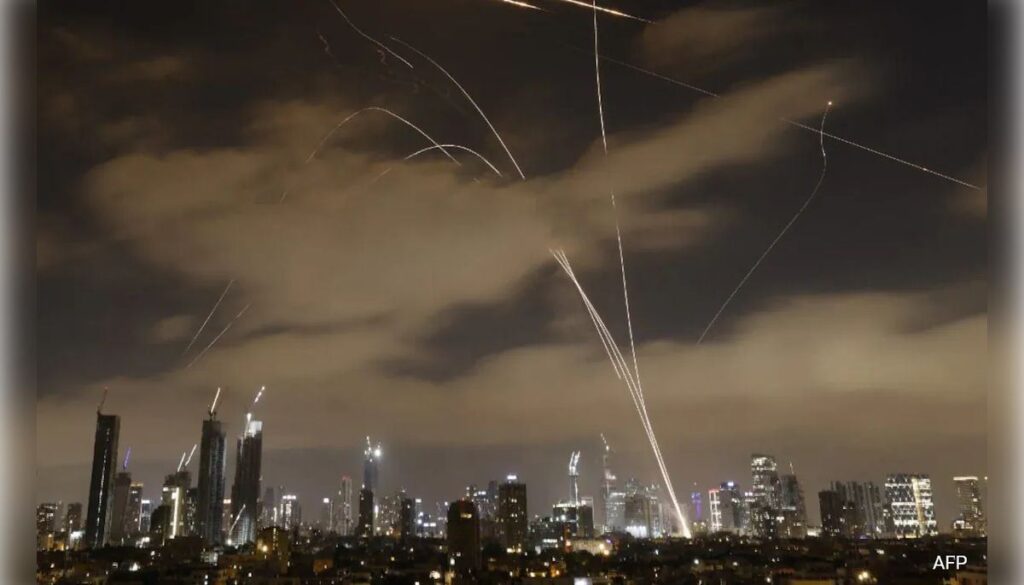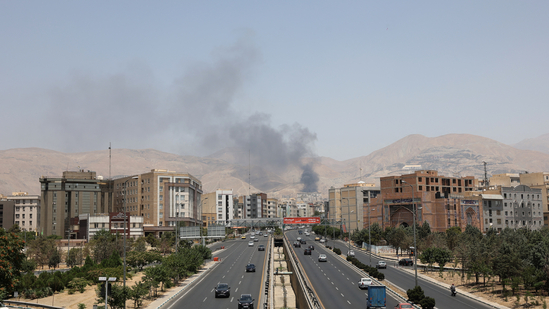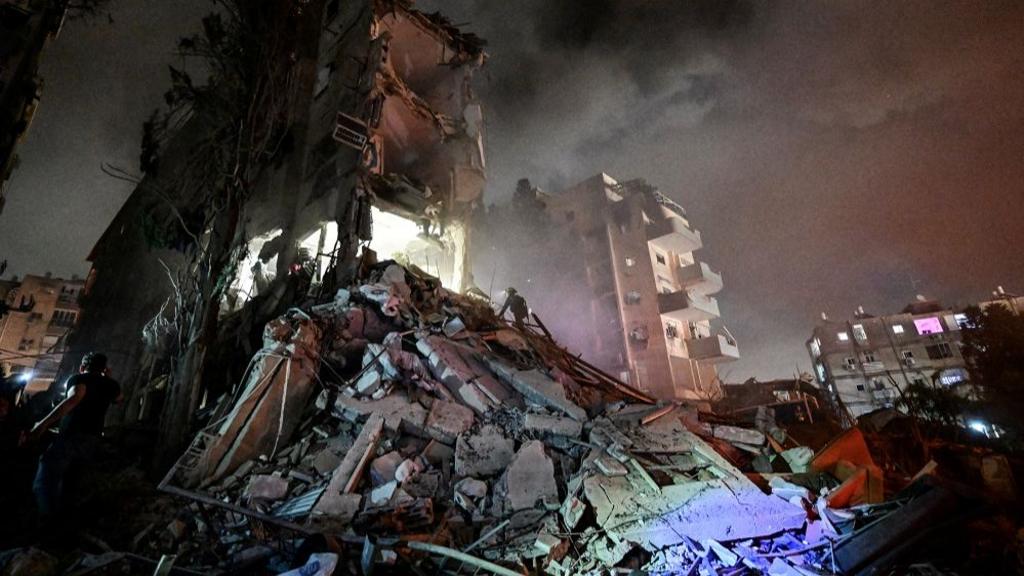1. Turn of Events – Six Days into “Operation Rising Lion”
The Israel–Iran conflict has erupted into full-scale warfare, now in its sixth consecutive day following Israel’s surprise attack on Iranian nuclear and military installations under Operation Rising Lion last Friday. This first-phase strike devastated Iran’s nuclear program and killed several top IRGC commanders closely tied to Ayatollah Khamenei (reuters.com, nypost.com).
In response, Iran launched an intense barrage of both conventional and claimed hypersonic missiles at Israel. While Israel intercepted approximately 95–99% of these incoming missiles using Iron Dome and Arrow systems, several still caused fatalities and near-misses in cities like Tel Aviv and Haifa (apnews.com).
2. Hypersonic Missile Exchange: A Tactical Leap
Iran announced it fired its new Fattah‑1 hypersonic missiles over the past 24 hours—a move symbolizing extreme escalation. These missiles claim speeds of Mach 13–15 and ranges up to 1,400 km (apnews.com).
- Despite initial claims, Western experts doubt Iran deployed maneuverable hypersonics; lack of maneuverability disqualifies them as true hypersonic weapons (apnews.com).
- Israel’s multi-layered defenses—Iron Dome, David’s Sling, Arrow 3, and the emerging SkySonic interceptor—effectively neutralized over 95% of threats, though precise hits remain a concern (iranintl.com).
- Hypersonic missile deployment underscores Iran’s intent to signal a strategic shift beyond traditional ballistic exchanges.
3. U.S. Involvement Escalates: Trump’s Ultimatum

On Tuesday, Donald Trump demanded Iran’s “unconditional surrender”, declaring its air defenses nonexistent and US skies fully controlling Iranian airspace (reuters.com).
- He confirmed awareness of Ayatollah Khamenei’s location but reassured he would not be targeted “for now” .
- Trump’s National Security Council convened after he departed the G7 early. Meanwhile, the U.S. is reinforcing the region with jet fighters, B‑52 bombers, and warships—though offensive use has not been authorized .
4. Leadership Messages & No Surrender
Ayatollah Khamenei:
- Declared on Day 6 that Iran would never surrender, calling Israel’s initial strike a “huge mistake” and promising punishment (reuters.com).
- Warned the U.S. against intervening, which he said would lead to “irreparable damage” .
Donald Trump:
- Reiterated that civilian and U.S. lives were not intentional targets and claimed patience was “wearing thin” (reuters.com).
Benjamin Netanyahu:
- Confirmed Israeli air dominance over Tehran and readiness to strike nuclear sites like Fordow if needed (thetimes.co.uk).
5. Cyberstrikes & Media Breach
Iranian state TV was briefly hacked, broadcasting protest footage and urging mass demonstrations. Tehran TV blamed “Zionist cyber attackers” for the disruption . This represents a significant move toward cyber warfare, showing that the conflict extends beyond physical borders.
6. Human & Structural Cost
- Iran reports approximately 224 civilian deaths, with total casualties nearing 585 including military personnel (reuters.com).
- Israel confirms around 24 civilian deaths, with several additional injuries due to missile debris (reuters.com).
- Iran has lost key IRGC leaders and nuclear scientists, including Hossein Salami and Esmail Qaani, triggering strategic instability (en.wikipedia.org).
- Israeli infrastructure includes severe damage to missile silos and command & control systems, especially those tied to Tehran’s missile corps .
7. Global & Regional Dynamics

- U.S. Reinforcements: Deployments are positioned for defense, but precise roles and escalation thresholds remain fluid .
- Oil Market Volatility: Concern over Persian Gulf disruptions and ports like Strait of Hormuz triggered a ~9% spike in prices (reuters.com).
- International Pressure: UK, France, Germany, and the UN are urging calm, advocating humanitarian corridors and evacuation of civilians .
8. Strategic Analysis & What Comes Next
- Next Phase: Iran may refine missile tactics using less detectable ballistic variants, even after hypersonic claims (telegraph.co.uk).
- U.S. Threshold: Reports suggest Trump may authorize a bunker-buster strike on Iran’s Fordow nuclear facility if warranted (thetimes.co.uk).
- Cyber Warfare: Iran’s hack was likely retaliatory; expect escalating cyber disruptions targeting communications and power grids.
- Defense Sustainability: Israel’s Arrow interceptor stockpiles are being depleted—likely sustainable for at most 12 days at current rates (economictimes.indiatimes.com).
- Nuclear Ambitions: Iran continues to assert peaceful nuclear intent, while IAEA flags facility damage—raising global scrutiny.
9. Humanitarian Toll and Civilian Life
- Iran’s urban centers like Tehran, Karaj, and communities near nuclear plants have suffered extensive civilians damage and power blackouts.
- Israel’s central and northern regions endure air raid sirens, growing shellshock, and mandatory civilian evacuations.
- Around 120,000 individuals across both countries have been displaced, depending on embassy and international aid to escape strikes.
UK Must Approve US Use of Diego Garcia Base Before Any Strike on Iran – Cobra Meeting Update

1. Background: Diego Garcia Base and UK Sovereignty
Diego Garcia, located in the British Indian Ocean Territory (BIOT), is a critical joint UK‑US military facility. In May 2025, the UK and Mauritius finalized a 99‑year lease whereby Mauritius regained sovereignty over the Chagos Islands, including Diego Garcia, but the UK retained operational control via a long-term lease, paying approximately £101 million/year (apnews.com).
- The base has supported major Middle East, South Asia, and East Africa operations against terrorist and hostile threats (gov.uk).
- The UK retains full legal authority and control over base access and electromagnetic spectrum use (gov.uk).
2. 🇬🇧 UK-US Authority: Why UK Sign-Off Is Mandatory
Any US military operation using Diego Garcia requires explicit UK government approval, as confirmed in the Guardian and Financial Times:
- The US acknowledges Diego Garcia falls under UK sovereign control and must seek permission for its use (thetimes.co.uk).
- Legal and diplomatic norms prohibit US unilateral use of the base without UK involvement.
- Home Secretary Lord Hermer warned on legal ramifications and advised against UK over-involvement, except in a defensive context (theguardian.com, thetimes.co.uk).
- UK also controls access to nearby RAF Akrotiri in Cyprus and logistical approvals.
3. Cobra Meeting: Starmer’s Emergency Response
Upon his return from the G7 summit, Prime Minister Keir Starmer convened an urgent Cobra meeting—the UK’s top civil-military coordination committee—to assess Britain’s strategic options amid the escalating Israel‑Iran conflict (theguardian.com).
Scope:
- US might request Diego Garcia for military operations against Iran.
- UK must factor legal, political, military, and alliance pressures.
- Options on the table:
- Deny access to bases altogether.
- Grant limited logistical support (refueling, transit).
- Fully back US strikes and allow use of Diego Garcia.
Key ministers and officials, including Sir Keir Starmer, Foreign Secretary David Lammy, and national security advisers, participated.
4. Context: US Considering Strikes on Iran

US President Donald Trump has indicated military involvement could occur if diplomacy fails, demanding “unconditional surrender” from Tehran and suggesting US air dominance over Iranian airspace (theguardian.com, thetimes.co.uk, bbc.co.uk, ft.com, thetimes.co.uk).
- The US Navy’s USS Nimitz carrier strike group is positioning in the Middle East in preparation (ft.com).
- Speculation includes a possible strike on Iran’s heavily fortified Fordow nuclear facility, requiring GBU‑57 bunker-buster bombs and stealth B‑2 bombers launched from Diego Garcia (ft.com).
- Without UK approval, the US would need to launch such operations directly from its own bases or aircraft carriers.
5. Legal & Political Constraints in the UK
A. Domestic Legal
- Lord Hermer emphasized that any support must maintain legality under British and international law, suggesting a defensive-only scope.
- Some MPs and Conservative figures warn the government must avoid entanglement without due process (thetimes.co.uk).
B. Political Costs
- Allowing the strike might fray UK domestic politics and public sentiment, especially given anxiety over entering another conflict-broader ideological backlash.
- Denial could irritate the UK-US “special relationship”, an important long-term strategic anchor.
C. Strategic Diplomacy
- Starmer’s message is clear: the UK advocates de‑escalation, pursuing a diplomatic route and urging restraint as tensions spread regionally (theguardian.com).
- The option to support a UN Security Council session underscoring a multilateral path provides a counterbalance to military options.
6. Regional and Global Implications
A. UK Strategic Positioning
- Allowing US use maintains UK influence in Indo-Pacific, South Asia, and Middle East theaters.
- Denial may shift dependence toward US NATO-only pathways, diluting British clout.
B. Global Security & Oil Markets
- Any strike risks provoking Iranian retaliation across the Straight of Hormuz, threatening oil flows and global stability.
- Ongoing escalation could inflame broader conflicts, drawing in Hezbollah, Houthis, or missiles to Cyprus, Gibraltar, or UK Gibraltar naval assets.
C. Diplomatic Channels
- Meanwhile, foreign ministers from Germany, France, UK, and EU plan talks with Iran in Geneva, an indication that diplomacy remains an active option (theguardian.com).
- The UN Security Council is set to hold another session Friday to explore ceasefire options and avoid broader conflagration (theguardian.com).
7. Diego Garcia Post-Chagos Deal: High Stakes for UK
The May 2025 Chagos sovereignty transfer was critical:
- UK retains usage rights for 99 years, with access to a 24-nautical-mile buffer zone (apnews.com).
- This military hub supports B-2 stealth, drone, and U2 operations, offering supersonic strike capabilities.
- Sovereignty protection shields against third-party incursions, particularly Chinese naval interest (thetimes.co.uk).
8. Possible UK Responses & Scenarios
| Scenario | UK Role | Implications |
|---|---|---|
| US requests base for Iran bombing | UK can grant or deny permission | Granting may anger public and legal critics; denial strains US-UK relations. |
| Limited US anti-Iran flights/refuel ops | UK could allow refueling or logistics support | Legal cushion if not directly used to strike. |
| Full UK‑US strike coordination | Joint operation involving Diego Garcia | High legal, political risk; may cross war declaration threshold. |
| UK refuses all cooperation | Deny use and logistical access | UK retains diplomatic independence, risks fraying alliance with US. |
The most probable UK path: limited logistics support, distancing from direct attack involvement while preserving alliance trust.
9. Official Statements & Reactions
- Sir Keir Starmer: “We urge de-escalation… will carefully consider any request through Cobra.” (ft.com, thetimes.co.uk, theguardian.com, theguardian.com).
- Foreign Secretary Lammy: Held urgent talks in Washington—noted desire to prevent war (theguardian.com).
- Lord Hermer (Attorney General): Warned against MGK use of UK bases for offensive ops; defensive only (thetimes.co.uk).
- US Military: Admit seeking permissions from UK for Diego Garcia usage (theguardian.com).
- Conservative critics: Argue denying could diminish UK global influence (apnews.com).
10. The Path Ahead

Short-Term:
- Cobra will finalize UK position on any US request.
- G7 allies and German‑French‑UK envoys meet Tehran Friday amid diplomatic pressure.
- UN Security Council session may shift global narrative.
Medium-Term:
- US intelligence remains fractured; Trump hasn’t made final strike decision (theguardian.com).
- UK decision on Diego Garcia will shape NATO cohesion and possibly expedite or deter US intervention.
Long-Term:
- UK strategy will be scrutinized by voters, parliaments, and military analysts.
- Continued access to Diego Garcia hinges on public and parliamentary acceptance of UK’s strategic choices.
- Broader Chagos legacy and base utility will influence UK defense posture in Indo-Pacific.
Summary
- The UK must grant permission for any US use of Diego Garcia in strikes on Iran.
- Starmer convened Cobra to weigh legal, political, and alliance dynamics.
- Options range from denial to limited logistic assistance or full military involvement.
- UK legal counsel recommends defensive-only support to avoid war-like entanglement.
- The balance: supporting US strategic priorities vs. preserving diplomatic autonomy and public accountability.
- Upcoming UN and Geneva diplomatic milestones may limit or influence UK’s decision-making.
Key Bullet Points
- Day 6 of Iran‑Israel air war sees continued missile and cyber exchanges.
- Iran launched claimed hypersonic Fattah‑1 missiles, intercepted at >95 % rate.
- Khamenei stands firm: “No surrender.”
- Trump demands “unconditional surrender,” claims U.S. air dominance.
- U.S. jets, warships are in-position, ready for potential strikes.
- Iran lost IRGC commanders; Israel claims air superiority.
- Israel hacked Iranian state TV; cyber warfare intensifies.
- Civilian & structural damage mounting in both nations.
Quotes That Define the Crisis
- Khamenei: “This nation will never surrender.” (en.wikipedia.org, reuters.com, thetimes.co.uk)
- Trump: “UNCONDITIONAL SURRENDER!” — also warned Iran is “defenseless.” (reuters.com)
- Trump: “We know exactly where the Supreme Leader is hiding… not going to take him out… for now.” (reuters.com)
What to Watch Next
- Does Iran truly deploy maneuverable hypersonic missiles?
- Will the U.S. join airstrikes, hitting facilities like Fordow?
- Arrow system depletion and Israel’s readiness.
- Regional escalations via Hezbollah, Houthis—global ripple effects.
- Moves toward de-escalation, such as U.N.-mediated ceasefires or diplomatic channels.

